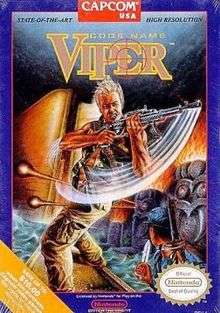Code Name: Viper
Code Name: Viper, originally released as Ningen Heiki Dead Fox (人間兵器デッドフォックス, Ningen Heiki Deddo Fokkusu, lit. "Human Weapon Dead Fox"), is a side-scrolling action game programmed by Arc System Works and released by Capcom in 1990 for the Nintendo Entertainment System. The player takes control of a special forces operative who must combat a drug syndicate in South America.
| Ningen Heiki Dead Fox Code Name: Viper | |
|---|---|
 North American cover art | |
| Developer(s) | Arc System Works[1] Capcom(Graphics & Sound) |
| Publisher(s) | Capcom |
| Composer(s) | Junko Tamiya (Stage 1 only)[2] Yoko Shimomura |
| Platform(s) | NES |
| Release | |
| Genre(s) | Action, Shooter |
| Mode(s) | Single-player |
Plot
The player takes the role of Kenny Smith, code name "Viper", an agent of the 98th Special Forces. He is assigned by his commander, Director Jones, to investigate a large drug syndicate that covers all of South America. Smith's objective is to rescue a missing agent in each of the syndicate's seven hideouts and uncover clues of the Syndicate's true mastermind.[3][4]
Gameplay
.png)
The gameplay system is similar to Namco's 1986 arcade game Rolling Thunder, specifically its own NES version. Like in Rolling Thunder, the player can jump or drop down between floors by holding the directional pad up or down and pressing the jump button, as well as enter doors to obtain power-ups or avoid enemies. The player can be armed with one of two weapons (a standard issue pistol or a fully automatic machine gun for continuous firepower). Items includes additional ammunition for either weapon, extra health, a time extension, and extra lives. Unlike Rolling Thunder, the player can shoot while jumping and can also change directions during midair.
Another difference between Rolling Thunder and Code Name: Viper is the added emphasis on rescuing hostages, like the also-similar Shinobi. Throughout the first seven stages, the player can find captured civilians behind certain doors, who will offer the player their gratitude. To complete each of the first seven stages, the player must rescue a captured commando who will provide the grenades necessary to blow up the obstruction blocking the exit at the end of each stage and provide more revelation on the plot.
Per Rolling Thunder, the strength and attack patterns of the standard enemy soldiers that the player will face is determined by the colors of their outfit,[4] and "strange" enemies such as Snipers, Frogmen, and Maniacs appear later on.[5][6] There are a total of eight stages, with three difficulty settings.
References
- http://www.vgmpf.com/Wiki/index.php?title=Code_Name:_Viper_(NES)
- Tamiya, Junko. "Junko Tamiya Interview: Creating Capcom's Incredible NES Scores". Game Music Online. Retrieved 20 May 2014.
- "Preview - Code Name: Viper". Nintendo Power. No. Volume 11. March–April 1990. pp. 46–47.
- "Features - Code Name: Viper". Nintendo Power. No. Volume 12. May–June 1990. pp. 32–37.
- Capcom. Code Name: Viper (Nintendo Entertainment System). Level/area: Instruction manual, page 11.
- Capcom. Code Name: Viper (Nintendo Entertainment System). Level/area: Instruction manual, page 12.